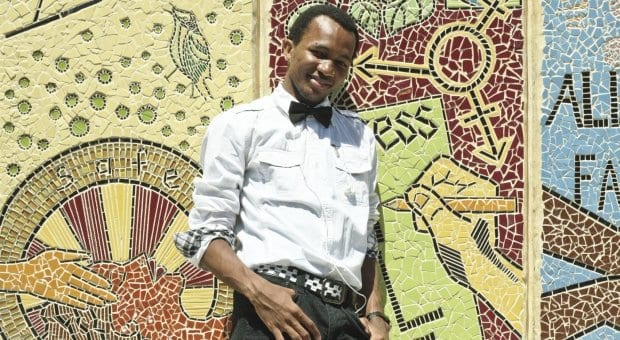When they reached the lake, Elvis Tjijorokisa protested that the water was too deep, that he didn’t trust his life jacket, but to no avail. Before he knew it, his campmates tipped his canoe and he was floating in Lake Temagami. “After that, I didn’t want to come out of the water,” he recalls with a smile.
The canoe test was a relatively minor challenge for Tjijorokisa, who just one year earlier had immigrated from Namibia seeking refugee status. Namibia does not recognize gay rights and inherited Roman-Dutch anti-sodomy laws from South Africa.
For Tjijorokisa, the decision to leave Namibia was a sudden one. It happened the day he turned 21. His aunt was hosting his birthday party, and as he was heading over, he received a text from a friend warning him to stay away, that the police were waiting for him. His uncle, suspecting he was gay, had reported him.
That evening, he skipped the party and got on a plane to Canada. “Nobody knew about it, not even my mom,” he says.
On his own in a new country, he wasted no time setting up his life, quickly getting a lawyer and immersing himself in Toronto’s LGBT community. Initially, public displays of affection felt risky, even receiving a hug from a friend, but he soon adjusted, going clubbing for the first time and attending his first Pride.
“Every day, it was a mission for me . . . to go on Church Street and just explore,” he says. Keen to try everything, when Tjijorokisa discovered Supporting Our Youth’s (SOY) Get Out canoe trip, he signed up immediately.
In the documentary Nature’s Invitation, Robert Bateman says, “New immigrants, if they want to really partake of Canada, devour Canada, become a bit more Canadian, I think that nature is absolutely a must.”
But communing with nature may not be the quintessential Canadian activity it once was. In a David Suzuki Foundation survey of Canadian youth, 70 percent of respondents said they spend an hour or less outside each day, while according to Active Healthy Kids Canada, youth spend six to seven hours a day in front of screens.
Programs like SOY’s encourage youth to drop their gadgets and get some fresh air. Get Out offers free monthly events like cycling, skating and skiing to queer people under 29. No experience is necessary.
“It’s about being outside and participating,” says coordinator Adam Benn. “It’s not about winning or losing, so I think it makes it a positive experience for everybody.”
Though he had never canoed before, Tjijorokisa knew he’d love the experience. “Going out into nature, me coming from Africa, that was just a connection,” he says. Back in Namibia, his family had a farm, where they would spend weekends riding horses, climbing trees and rock climbing.
Still, he wasn’t totally prepared for the Get Out camping experience. A snappy dresser, Tjijorokisa was dismayed to learn that his suitcase of clothes couldn’t come along for the trip. His phone, loaded with music, had to be left behind, too.
But when they got to the lake, he felt great. “I just wanted to stay on the water and paddle and paddle,” he says. On the first day of the eight-day trip, some of his campmates complained about having to share tents, but after staying up all night talking, Tjijorokisa says, the group bonded, and the week flew by with portaging, canoeing, singing and dancing.
Since that trip, Tjijorokisa has been attending Get Out events regularly and keeping busy within the queer community. He’s now applying to universities and ultimately hopes to study international human-rights law. In the near future, he is gearing up for August’s canoe trip, where he’ll be taking on more of a mentorship role.
“People on my trip, they’re going to have a good time,” he promises.
For more information on SOY and Get Out, visit soytoronto.org.

 Why you can trust Xtra
Why you can trust Xtra


